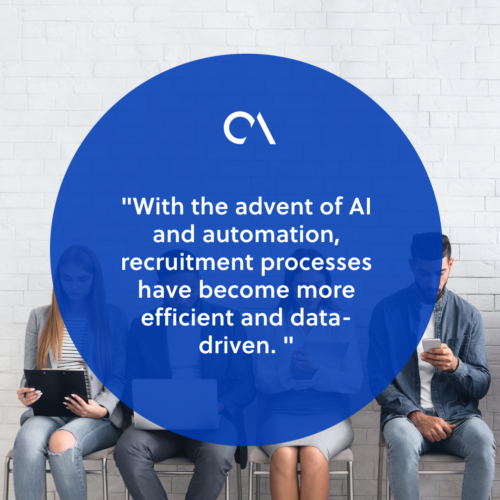Exploring the latest recruiting trends that will shape 2025

In talent acquisition, staying ahead is key to success. However, there will always be challenges as companies adapt to recruitment innovations.
As we move forward to 2025, let’s explore the latest recruiting trends shaping hiring processes. We’ll discuss today’s recruitment challenges, as well as the benefits of implementing advanced methods.
How innovation shapes the latest recruiting trends
Today’s technological advancements significantly impact the latest recruiting trends:
- With the advent of AI and automation, recruitment processes have become more efficient and data-driven.
- Video interviewing platforms and virtual reality simulations have revolutionized how companies assess candidates remotely, offering a more immersive and interactive experience.
- Social media and professional networking sites like LinkedIn have made identifying and connecting with potential candidates easier.
- Data analytics plays a crucial role in predicting future talent needs and identifying areas for improvement in the hiring process.
Overall, these tech developments are streamlining recruitment processes and enhancing candidate experiences. They help organizations make more informed decisions in their talent acquisition efforts.

Challenges in implementing the latest recruiting trends
Embracing new recruiting trends comes with drawbacks. Recognizing and planning for these challenges ensure a smooth implementation process:
Technological barriers
As we embrace a technology-driven approach to hiring, there’s a clear disparity in how businesses adapt.
Smaller companies, constrained by budget limitations and limited resources, may encounter difficulties incorporating the latest recruitment technologies.
Data privacy and security
Recruitment processes gather valuable personal and sensitive information which companies use for informed hiring decisions, such as:
- Resumes
- Contact details
- Social security numbers
- Occasionally personality assessments
Nevertheless, this valuable data also presents an appealing opportunity for cybercriminals.
Overreliance on technology
Overreliance on technology raises a major concern – the possible absence of the human touch.
Candidates eventually require interactions with actual individuals. They have questions, concerns, and unique characteristics that algorithms may not fully address.
Bias in AI and algorithms
Algorithms and AI systems are designed to analyze large datasets and make predictions or decisions based on patterns in the data. However, these patterns can be influenced by biases present in the historical data.
For example, if past hiring decisions showed bias towards a particular gender or ethnicity, an algorithm trained on this data might unintentionally maintain these biases.
Candidate experiences challenges
A smooth candidate experience is key to successful recruiting, but new trends can sometimes make it difficult for candidates.
Lengthy online tests, automatic rejections, and limited personal communication can be frustrating.
10 latest recruiting trends that will define 2025
Now that we understand the challenges of implementing the latest recruiting trends, let’s explore the ten trends defining recruiting in 2024.
1. Remote and hybrid work
In 2024, bring a mix of working from home and going to the office. Companies should let employees decide where they want to work.
Imagine having an employee sipping coffee at home while attending online meetings with their colleagues worldwide, then collaborating with their team in a fancy office the next day.
It is going to be exciting!
2. Diversity, equity, and inclusion (DEI)
In hiring, DEI isn’t just a trendy term anymore; it’s a big change in thinking. Businesses aren’t satisfied with meeting diversity goals; they wholeheartedly embrace fairness and inclusion.
Think about a workplace where employees from different backgrounds get along and do really well together.
In 2024, companies should actively search for talent from:
- Various backgrounds
- Genders
- Abilities
They must understand that diversity isn’t just a box to check; it’s a source of new ideas and creativity.
3. Skills-based hiring
Forget about diplomas and fancy job titles; 2024 is all about skills-based hiring.
In a world where anyone can acquire certifications and develop skills online, relying solely on formal education is no longer sufficient. The skills-based trend is changing how recruiters assess candidates.
Employers should be interested in the candidate’s accomplishments and character, not just what they’ve studied.
4. Blockchain for verification
Have you ever questioned the authenticity of a candidate’s resume? In 2025 blockchain technology will enter the recruitment arena to ensure transparency and trust.
Blockchain will create unchangeable records of a candidate’s qualifications, work history, and certifications. It means no more exaggerated claims or fabricated achievements.
Recruiters can have confidence that the digital resume accurately represents the truth. It’s like a digital notary stamp for your career.
5. Flexible benefits and perks
In 2024, employee benefits and perks are transforming. It’s not just about having ping-pong tables and free snacks anymore.
Companies are now focusing on customized perks that cater to individual needs.
Imagine a workplace where you can select your perks as if ordering from a menu. Need extra time off? A wellness allowance? Or assistance with childcare?
Employers should go the extra mile to ensure their team is not just satisfied but flourishing.
6. Health and wellbeing
In 2024, it’s not only about physical health but holistic well-being. Companies should invest in employee wellness programs that go beyond gym memberships.
Imagine a workplace that promotes mindfulness, provides mental health resources, and even offers stress-relief activities during work hours.
Happy, healthy employees are not only more productive but also more loyal.
7. Artificial intelligence (AI) tools
Artificial intelligence has emerged among the top recruiting trends due to its transformative impact on hiring. AI-powered tools are increasingly integrated into recruitment practices as they:
- Streamlines the hiring process
- Improves decision-making
- Enhances the candidate experience
- Offers cost-effective solutions for talent acquisition
8. Continuous learning and upskilling
2024 is the year of lifelong learning. The fast pace of change in industries demands that employees continuously update their skills.
Imagine a workplace where you’re encouraged and supported in acquiring new skills through online courses, workshops, or mentorship programs.
It’s not about age; it’s about the eagerness to learn and adapt.
9. Data driven recruitment
Data-driven recruitment involves using data and analytics to make informed decisions at every stage of recruitment, from sourcing candidates to making final selections.
By leveraging data and analytics, companies can optimize their recruitment processes, enhance the candidate experience, and stay ahead in the competitive talent acquisition landscape.
10. Personalization
2024 is the year of personalized recruitment experiences. No more one-size-fits-all approaches.
Employees must receive
- Job recommendations that align with their skills and aspirations
- Tailored coaching to help them excel in interviews
- The feedback that genuinely supports their growth.
Personalization isn’t just a buzzword; it’s a commitment to making the recruitment process more human and meaningful.

Benefits of using the latest recruiting trends
Below are some key benefits associated with incorporating these trends into your recruitment strategies.
Improved candidate experience
One of the significant advantages of adopting the latest recruiting trends is the potential for a vastly improved candidate experience.
Streamlined processes, personalized communication, and faster response times can leave a positive impression on job seekers.
Access to a larger talent pool
Technology enables companies to cast a wider net when searching for talent. With remote work becoming more prevalent, geographical boundaries are no longer a significant limitation in hiring.
Faster time-to-hire
Traditional recruitment processes can be time-consuming. The latest trends can significantly reduce the time it takes to fill open positions.
Better quality hires
By leveraging data and AI, companies can identify candidates whose skills and experiences align perfectly with the job requirements. This leads to higher-quality hires more likely to excel in their roles.
Cost savings
Efficiency in the hiring process translates to cost savings. Companies can reduce the resources spent on lengthy recruitment cycles and reallocate those resources elsewhere.
Enhanced employer branding
A smooth and positive candidate experience, along with the use of cutting-edge recruitment technologies, can enhance a company’s reputation as an employer.
This, in turn, can attract more top-tier talent.
Latest recruiting trends best practices
Here’s how you leverage the latest recruiting trends effectively:
Stay informed
Recruitment is not a static process; it evolves with time. Staying informed about the latest industry trends is crucial.
Join industry-specific forums, attend conferences, and subscribe to newsletters to keep your finger on the pulse. Understanding the current landscape will enable you to adapt your strategies effectively.
Leverage data
Data is the new gold in the recruitment world. Utilize analytics to measure the effectiveness of your recruiting efforts.
Analyze which channels bring in the most qualified candidates, which job descriptions resonate, and where the bottlenecks lie in your hiring process.
This data-driven approach will lead to more efficient recruitment.
Adopt technology wisely
Technology is a double-edged sword. While it can streamline processes, it can also overwhelm. Choose recruitment tools and software wisely.
Look for solutions that simplify tasks like resume screening, interview scheduling, and candidate tracking. These technologies can save you time and ensure a smoother recruitment process.
Balance automation and human touch
While technology is essential, the human touch remains irreplaceable. Strike a balance between automation and personal interaction.
Use automated systems for initial screenings and administrative tasks, but ensure that candidates also have meaningful interactions with your team.
This balance ensures a more personalized and humane recruitment experience.
Flexible job descriptions
Tailor your job postings to attract diverse candidates. Highlight your company’s culture, values, and opportunities for growth.
Be clear about the skills and qualifications required, but also emphasize your willingness to train and nurture talent.

Adjust to the changing environment using the latest recruiting trends
As we wrap up our journey through the ten latest recruiting trends that will define 2024, it’s clear that the future of talent acquisition is dynamic and exciting.
So, if you are an employer seeking the brightest talent, 2024 promises to be a year of innovation, inclusivity, and endless possibilities in the world of recruitment.
Embrace these trends, and you’ll be well-prepared for the thrilling recruitment landscape.







 Independent
Independent




